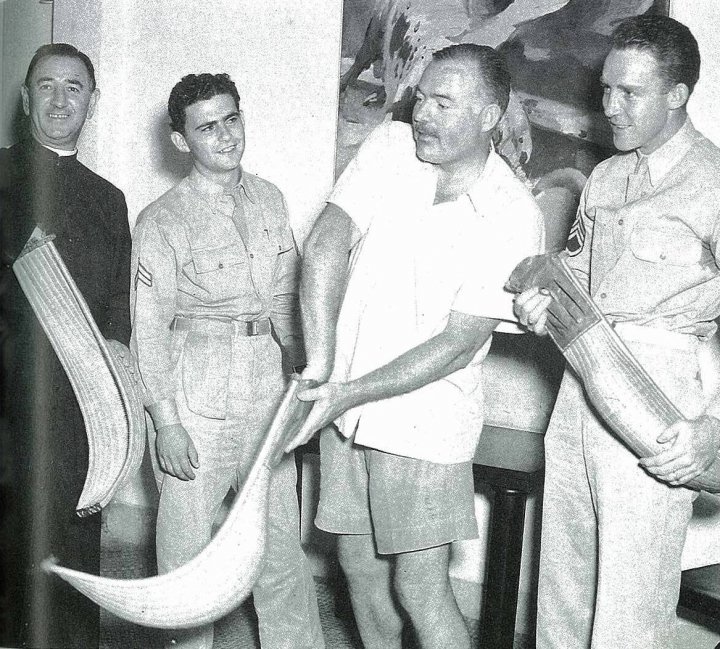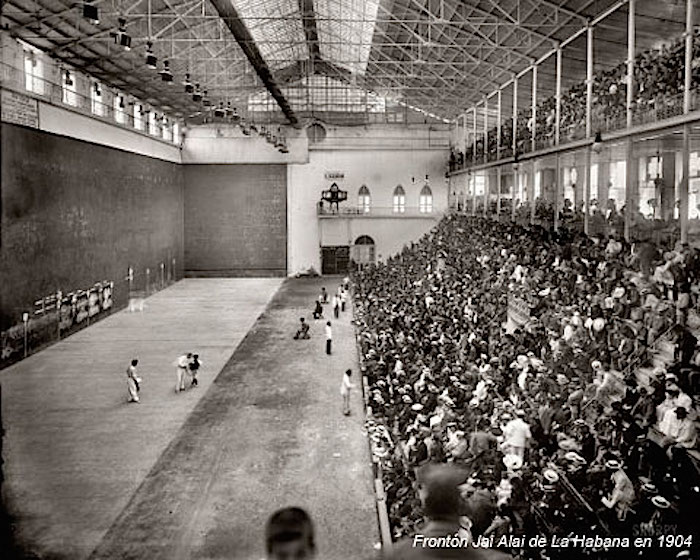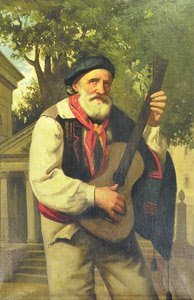This article was translated by John R. Bopp
There are times we find a loose thread in an article, and when we pull on it a bit, we discover a beautiful, incredible, fascinating world. This is one of those occasions.
It all started with an article about attempts to recover Basque handball in Cuba. It’s an article from the website Caribbean News Digital, which we’ve mentioned here before. The article mentions how in Santiago de Cuba, professor Orlando Regeuiro is trying to bring back the passion for a sport that was an authentic national pastime from Cuban independence through the Revolution. It’s without a doubt an uphill battle, since even the most basic equipment is scarce, even regulation courts–there’s only one in Santiago de Cuba.


The truth is that we’ve already mentioned many interesting things about Basque handball players in Cuba, especially their relationship with Ernest Hemingway and the adventures they (the ball players and the author) had together during the Second World War, trying to “hunt” German submarines off the Cuban coast. The American journalist and author had a close relationship with everything Basque, which he maintained throughout his life.
That may be why our curiosity was piqued when we read this statement in that article:
The practice of this sport in Cuba goes back to 1881, when there was a society of Basque, Navarrese, and French players in Havana who held matches that were ever more popular and well attended.
We’re not going to dig (too) deep into that line about Basque, Navarrese, and French: they were all Basques coming from the different parts of the country that are under different administrations, and in those times words like Iparralde and Hegoalde (the Northern and Southern Basque Countries, respectively) were still just gaining currency as the idea of Basque nationalism was beginning. It was a movement that from its very beginnings right up to the First World War had the Basques north of the Pyrenees playing a very important role. To understand this movement to recover Basque nationalism in the Northern Basque Country and the “creation of the French state” factor that came from the tragic massacre that was the Great War, all we have to do is follow the work of that universal Basque, Maurice Ravel, which you can do here and here.
But we promised we weren’t going to get caught up in all that. The question is that this society immediately reminded us of another founded in the Americas, but more further north, in Saint-Pierre and Miquelon. This is the Zazpiak Bat Association, which was founded in 1902. As you can see, the union between all Basques came back strong, as did the weight that this idea had amongst the Basques under French administration.
The idea that these two goals, Basque handball and the relationship among all Basques, came up in two such completely different places seemed to suggest something important to us. Aso we dug a bit deeper. It didn’t take us long to discover a ton of really interesting information that filled us with enthusiasm, and most of this is thanks to the extraordinary work of just one Basque, Angel Gonzalez Katarain.
He was responsible for the making a documentary called “Belascoain”, the first in a series called “Seven Streets in Havana,” which is about seven Basques who gave their names to streets in the Cuban capital. The series is extraordinarily interesting and which totally belongs in our section on “Basques in the World”.


This first documentary tells the story of Basque handball players in Havana. This street, officially Padre Varela Street, but which everyone calls Belascoain, was where handball players traditionally stayed when travelling to the Cuban capital. Gonzalez took advantage of that starting point to tell us the story of this sport in Havana. But his website is an even more informative source, and anyone interested in the sport or the history of Basques in Cuba should definitely check it out. There, you’ll find photos, posters, explanatory texts, and a ton of useful information. The document Basque Handball in Cuba stands out from the rest, though, giving us a “brief summary” of the history.
Jai-Alai and the Tree of Guernica
And now we come to some really spectacular information. The setting is 1901, just three years after the end of the Cuban War for Independence against the motherland that brought them into the Spanish-American War in 1898 and which triggered the final loss of the last colonial possessions Spain had, including Cuba.
At that time, Cuba was in the middle of building its republic. The American occupiers wanted Cuba to be free but were tied up by American interests in the country. A year and a half after the start of the American occupation, on July 25, 1900, an election was called to vote for the people who would draw up the Constitution. The Constitutional Assembly drafted and approved the Cuban Constitution in 1901, and Cuban independence was finally achieved on May 2, 1902.
It must also be kept in mind that in these colonial wars, Basques south of the Pyrenees were drafted for the first time. Not that everyone was forced to serve in the army of the Kingdom of Spain: the sons of the liberal families that had helped end the Basque fueros south of the Pyrenees were exempted. The rest, the vast majority of young Basque men, were forced to fight in Cuba, or the Philippines, or to escape, usually to South America.


So, in that environment, in the middle of 1898, a group of Basques came up with the idea of building a jai alai court in Havana, where there was already quite a fanbase for the sport (and betting on it). It must have been an attractive plan that found enthusiastic backers, because they managed to convince the American military governor, Leonard Wood, that this project, the Havana Jai Alai Court, was a good idea. And Wood must have been very well convinced, because he decisively supported “the Basque sport of jai alai along with its bets.”
As the text reads: “On March 3, 1901, the jai alai court was opened in a solemn ceremony with the presence of the main municipal leaders and representatives of the Cuban government and the American military authorities, as well as the Spanish Consul. In an atmosphere of concordance, the bishop blessed the facilities and both Diego Tamayo, the Secretary of State, and Leonard Wood praised the Basque colony.”
The season started seven days later, and did so in a very “unconventional” way. We can imagine that since the United States still controlled the island, the American national anthem started off the games; we can also imagine that since those interested in promoting a “friendly independence” also had the Cuban anthem played.

Well, as it turns out, neither the American nor the Cuban anthems were played. What was played was the Basque anthem, the song “Gernikako Arbola (The Tree of Guernica)”. Can you imagine it? A jai alai court in post-colonial Cuba, full of enthusiastic Cubans wanting to celebrate their recent independence, and also full of American military leaders who had just won a war, standing to listen to the work by Iparragire.
The website The Cuban History doesn’t give any more details about that day. But, since it couldn’t be any other way, we do know that before the inauguration, the authorities were invited to a lunch where Cod à la biscayne and (certainly Alavan) Rioja wine were served: a magnificent way to make “friends with the Basques.”
Things don’t change much
We can’t resist finishing off this story with a detail that caught our attention and has shown us that things don’t change much, if you’ll allow us the joke.

This Jai-Alai was the first in a series of courts that popped up in Havana and helped turn Basque handball into one of the two “national sports” of Cuba, alongside baseball. One of these courts, La Bombonera, was unusual in that matches were played by women, most of whom were hired in the Basque Country. This court had 140 windows and doors to make sure all 1800 seats were well aired out. It was the largest and most expensive jai alai court for women in the world. On its inauguration day in the 1920s, both the Cuban anthem and the “Gernikako Arbola” were played.
In the summary of the history of Basque handball in Cuba, we’re told:
“Those Basque misses in the 1920s, respected and admired by many Cuban hearts that were in love, beautiful and chaste, according to Antonio Méndez “quasi-nuns consecrated to the god of leather handball, were always accompanied by ladies when they took walks or went to run an errand.”
As we said before, there are a thousand and one wonderful stories we could tell just by going through all the information we’ve come across.
Firstly, for its extraordinary value, is the documentary “Belascoain.” We’ve linked to its trailer, about 15 minutes long, and the website where you can rent it and get to know the amazing amount of interesting information on Basque handball in Cuba. We’ll also leave you with a .pdf copy of “Basque Handball in Cuba,” which has been in large part the base for this article.
We’ll also leave you with the reference to the website The Cuban History, where they also speak about Basque handball, and tell us the story of Cod à la biscayne enjoyed on the day of the inauguration of the Jai Alai court in Havana; the article “Basque Handball” on the Conexión Cubana website; and, of course, the Caribbean News Digital article that got this whole article our ours started.
We hope you’ll enjoy reading this article as much as we did writing it. The role of “Basques in the World” is something that we find the more we explore it, the more we’re surprised, and the more important we see we Basques are. That’s why we really have to thank projects like Angel Gonzalez Katarain’s “Seven Streets in Havana”, which tells the story of extraordinary Basques.
Semillas en el Tiempo – – Euskadi/Cuba
Belascoain es el primer Documental de la serie Siete calles de La Habana
Es la calle hoy, la historia…, y un homenaje a los pelotaris que jugaron en cuba entre los años 1900 y 1960. Se llamó primero, en 1782, “Calle del Cocal”, porque había cocoteros plantados por la zona. Se llamó también “Calzada de la Beneficencia” porque la Casa de Beneficencia se edificó en 1793 en esa calle. Y también se llamó “Calle Gutiérrez”, nombre del constructor principal de la calle, un canario que llegaría a ser regidor de La Habana en 1812. Al perfilarse bien la calle, hacia 1844, se le dio el nombre de Belascoain por el general español Diego de León, Conde de Belascoain. Un jerifalte de la época colonial, amigo de Leopoldo O´Donnell. Era el tramo que iba de lo que entonces era Paseo de Tacón (después Carlos III, y ahora oficialmente Salvador Allende) a la Calzada del Monte (hoy oficialmente Máximo Gómez). El tramo dio nombre a toda la calle.
(Continue) (Automatic translation)
Trailer del documental Belascoain
La Pelota vasca en Cuba
http://www.semillaseneltiempo.com/resources/La+pelota+vasca+en+Cuba.pdf
——————————————-
The Cuban History – 23/7/2013 – Cuba
“BASQUE PELOTA” (Jai Alai) in Cuba (Video) * JAI ALAI (Pelota Vasca) en Cuba (Video)
The Pelota Basque has a certificate of naturalization in Cuba after the end of Spanish rule. We attempted to enter it during colonial rule, but it was postponing the matter and when they finally arrived in Havana was known and practiced in Brazil and Argentina, Italy, Egypt and, of course, in Spain. – La pelota vasca tiene carta de naturalización en Cuba después del cese de la dominación española. Se intentó introducirla durante la dominación colonial, pero se fue aplazando el asunto y cuando por fin llegó a La Habana ya se conocía y practicaba en Brasil y la Argentina, Italia, Egipto y, por supuesto, en toda España.
(Continue) (Spanish-English Bilingual Entry)
——————————
Conexión Cubana – 2014 -Cuba
LA PELOTA VASCA EN CUBA
Uno de los deportes que creció con la República y desapareció con su muerte en 1959 fue la pelota vasca o cesta punta, popularmente conocido como Jai Alai. El Jai Alai fue llevado a Cuba por los vascos en el año 1898, pero no fue hasta el 7 de mayo de 1901 que nació el primer templo de la pelota vasca en el Nuevo Mundo, cuando se inauguró en La Habana el Frontón Jai Alai en la famosa esquina de Concordia y Lucena. La obra no tardó en ganarse el nombre de ”El Palacio de los Gritos”, e impulsada por el vasco Basilio Sarazqueta atrajo a numerosos pelotaris del más alto nivel.
(Continue) (Automatic translation)
Last Updated on Jan 4, 2021 by About Basque Country




























